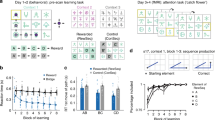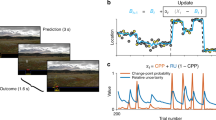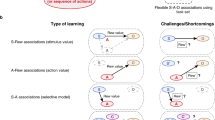Abstract
Learning depends on surprise and is not engendered by predictable occurrences. In this functional magnetic resonance imaging (fMRI) study of causal associative learning, we show that dorsolateral prefrontal cortex (DLPFC) is associated specifically with the adjustment of inferential learning on the basis of unpredictability. At the outset, when all associations were unpredictable, DLPFC activation was maximal. This response attenuated with learning but, subsequently, activation here was evoked by surprise violations of the learned association. Furthermore, the magnitude of DLPFC response to a surprise event was sensitive to the relationship that had been learned and was predictive of subsequent behavioral change. In short, the physiological response properties of right DLPFC satisfied specific predictions made by associative learning theory.
This is a preview of subscription content, access via your institution
Access options
Subscribe to this journal
Receive 12 print issues and online access
$209.00 per year
only $17.42 per issue
Buy this article
- Purchase on Springer Link
- Instant access to full article PDF
Prices may be subject to local taxes which are calculated during checkout



Similar content being viewed by others
References
Shanks, D. R. The Psychology of Associative Learning (Cambridge Univ. Press, Cambridge, UK, 1995).
Shanks, D. R., Medoff, D. R. & Medin, D. L. The Psychology of Learning and Motivation: Causal Learning (Academic, San Diego, 1996).
Schultz, W. & Dickinson, A. Neuronal coding of prediction errors. Annu. Rev. Neurosci. 23, 473–500 (2000).
McClelland, J. L., McNaughton, B. L. & O'Reilly, R. C. Why there are complementary learning systems in the hippocampus and neocortex: insights from the successes and failures of connectionist models of learning and memory. Psychol. Rev. 102, 419–457 (1995).
O'Reilly, R. C. & Rudy, J. W. Conjunctive representations in learning and memory: principles of cortical and hippocampal function. Psychol. Rev. 108, 311–345 (2001).
Waelti, P., Dickinson, A. & Schultz, W. Dopamine responses comply with basic assumptions of formal learning theory. Nature 412, 43–48 (2001).
Dickinson, A. Causal learning: an associative analysis. Quart. J. Exp. Psychol. B 54, 2–25 (2001).
Rescorla, R. A. & Wagner, A. R. in Classical Conditioning II: Current Research and Theory (eds. Black, A. H. & Prokasy, W. F.) 64–99 (Appleton Century Crofts, New York, 1972).
Buckner, R. L. Event-related fMRI and the hemodynamic response Hum. Brain. Mapp. 6, 373–377 (1998).
Friston, K. J. et al. Event-related fMRI: characterizing differential responses. Neuroimage 7, 30–40 (1998).
Wasserman, E. A., Elek, S. M., Chatlosh, D. L. & Baker, A. G. Rating causal relations: the role of probability in judgments of response-outcome contingency. J. Exp. Psychol. Learn. Mem. Cogn. 19, 174–188 (1993)
Raichle, M. E. et al. Practice-related changes in human brain functional anatomy during nonmotor learning. Cereb. Cortex 4, 8–26 (1994).
Fletcher, P. C., Shallice, T. & Dolan, R. J. “Sculpting the response space” - an account of left prefrontal activation at encoding. Neuroimage 12, 404–417 (2000).
Zeki, S. & Marini, L. Three cortical stages of color processing in the human brain. Brain 121, 1669–1685 (1998).
Fink, G. R. et al. The neural consequences of conflict between intention and the senses. Brain 122, 497–512 (1999).
Menon, V., Adleman, N. E., White, C. D., Glover, G. H. & Reiss, A. L. Error-related brain activation during a Go/NoGo response inhibition task. Hum. Brain Mapp. 12, 131–143 (2001).
Carter, C. S. et al. Anterior cingulate cortex, error detection and the online monitoring of performance. Science 280, 747–749 (1998).
Casey, B. J. et al. Dissociation of response conflict, attentional selection and expectancy with functional magnetic resonance imaging. Proc. Natl. Acad. Sci. USA 97, 8728–8733 (2000).
Botvinick, M., Nystrom, L. E., Fissell, K., Carter, C. S. & Cohen, J. D. Conflict monitoring versus selection-for-action in anterior cingulate cortex. Nature 402, 179–181 (1999).
Gehring, W. J. & Knight, R. T. Prefrontal cingulate interactions in action monitoring. Nat. Neurosci. 3, 516–520 (2000).
MacDonald, A. W., Cohen, J. D., Stenger, V. A. & Carter, C. S. Dissociating the role of the dorsolateral prefrontal and anterior cingulate cortex in cognitive control. Science 288, 1835–1838 (2000).
Wagner, A. D. et al. Building memories: remembering and forgetting of verbal memories as predicted by brain activity. Science 281, 1188–1191 (1998).
Brewer, J. B., Zhao, Z., Desmond, J. E., Glover, G. H. & Gabrieli, J. D. Making memories: brain activity that predicts how well visual experience will be remembered. Science 281, 1185–1187 (1998).
Liddle, P. F., Kiehl, K. A. & Smith, A. M. Event-related fMRI study of response inhibition. Hum. Brain Mapp. 12, 100–109 (2001).
Sussman, G. J. A Computational Model of Skill Acquisition (American Elsevier, New York, 1975).
Shallice, T. From Neuropsychology to Mental Structure (Cambridge Univ. Press, Cambridge, UK, 1988).
Miller, E. K. & Cohen, J. D. An integrative theory of prefrontal cortex function. Annu. Rev. Neurosci. 24, 167–202 (2001).
Fuster, J. M. The Prefrontal Cortex. Anatomy, Physiology and Neuropsychology of the Frontal Lobe (Lippincott–Raven, Philadelphia, 1997).
Fuster, J. M. Executive frontal functions. Exp. Brain Res. 133, 66–70 (2000).
Nelson, H. E. The National Adult Reading Test (NART) (NFER–Nelson, Windor, Connecticut, 1982).
Matute, H., Arcediano, F. & Miller, R. R. Test question modulates cue competition between causes and between effects J. Exp. Psychol. Learn. Mem. Cogn. 22, 182–196 (1996).
Friston, K. J. et al. Statistical parametric maps in functional imaging: a general linear approach. Hum. Brain Mapp. 2, 189–210 (1995).
Friston, K. J. et al. Spatial registration and normalisation of images. Hum. Brain Mapp. 2, 165–189 (1995).
Talairach, J. & Tournoux, P. Co-planar Stereotaxic Atlas of the Human Brain. (Thieme, Stuttgart, 1988).
Acknowledgements
We thank H. Matute, F. Arcediano and R.R. Miller for allowing us to use their drug and syndrome names. We also thank J.D. Pickard and members of the Wolfson Brain Imaging Center, Addenbrooke's Hospital, Cambridge. P.C.F. is supported by the Wellcome Trust. D.R.S. is supported by the UK Biotech and Biological Sciences Research Council.
Author information
Authors and Affiliations
Corresponding author
Rights and permissions
About this article
Cite this article
Fletcher, P., Anderson, J., Shanks, D. et al. Responses of human frontal cortex to surprising events are predicted by formal associative learning theory. Nat Neurosci 4, 1043–1048 (2001). https://doi.org/10.1038/nn733
Received:
Accepted:
Published:
Issue Date:
DOI: https://doi.org/10.1038/nn733
This article is cited by
-
Liraglutide restores impaired associative learning in individuals with obesity
Nature Metabolism (2023)
-
Neural correlates of Quran recitals: a functional magnetic resonance imaging (fMRI) analysis
Multimedia Tools and Applications (2023)
-
Precision weighting of cortical unsigned prediction error signals benefits learning, is mediated by dopamine, and is impaired in psychosis
Molecular Psychiatry (2021)
-
Identity prediction errors in the human midbrain update reward-identity expectations in the orbitofrontal cortex
Nature Communications (2018)
-
Abnormal reward prediction-error signalling in antipsychotic naive individuals with first-episode psychosis or clinical risk for psychosis
Neuropsychopharmacology (2018)



